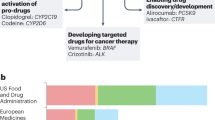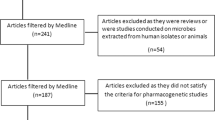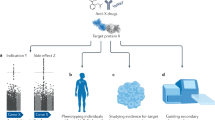Key Points
-
The latter portion of the twentieth century witnessed the emergence of the concept that inheritance is a major factor responsible for variation in drug response.
-
Once that principle had been established, the question immediately arose of the best way by which to translate this information to the bedside.
-
Here, after reviewing the process by which the disciplines of pharmacogenetics and pharmacogenomics have developed, we turn to challenges associated with the 'translation' of these disciplines from the research laboratory to the bedside, with the eventual goal of truly individualized drug therapy. These can be split into four major categories:
-
Pharmacogenomic science: Pharmacogenomics is moving beyond single-gene effects to study the effects of inheritance on pharmacokinetic and pharmacodynamic pathways involving multiple gene products. This type of study will require a large number of subjects and multi-disciplinary teams of investigators with complementary expertise, as well as the ability to genotype a very large number of polymorphisms or haplotypes.
-
Translational incentives: Successful translation of pharmacogenomics into the clinic will require the creation of positive incentives that will stimulate research funding agencies, academic centres, the pharmaceutical industry and drug regulatory agencies to work together to achieve translation.
-
Healthcare professional education: The translation of pharmacogenomics to the bedside will require the education of physicians and other healthcare professionals in clinical genomic science generally, and in its application to therapeutics in particular.
-
Patience acceptance: Patients will also have to become informed with regard to the application of genomics to drug selection and dosage. In addition, an effort will have to be made to keep patient expectations of pharmacogenomics realistic. Finally, patients must be assured that the confidentiality of their genomic information will be protected.
Abstract
Pharmacogenetics is the study of the role of inheritance in inter-individual variation in drug response. Since its origins in the mid-twentieth century, a major driving force in pharmacogenetics research has been the promise of individualized drug therapy to maximize drug efficacy and minimize drug toxicity. In recent years, the convergence of advances in pharmacogenetics with rapid developments in human genomics has resulted in the evolution of pharmacogenetics into pharmacogenomics, and led to increasing enthusiasm for the 'translation' of this evolving discipline into clinical practice. Here, we briefly summarize the development of pharmacogenetics and pharmacogenomics, and then discuss the key factors that have had an influence on — and will continue to affect — the translation of pharmacogenomics from the research bench to the bedside, highlighting the challenges that need to be addressed to achieve this goal.
This is a preview of subscription content, access via your institution
Access options
Subscribe to this journal
Receive 12 print issues and online access
$209.00 per year
only $17.42 per issue
Buy this article
- Purchase on Springer Link
- Instant access to full article PDF
Prices may be subject to local taxes which are calculated during checkout





Similar content being viewed by others
References
Lander, E. S. et al. Initial sequencing and analysis of the human genome. Nature 409, 860–921 (2001).
Venter, J. C. et al. The sequence of the human genome. Science 291, 1304–1351 (2001).
Weinshilboum, R. M. The therapeutic revolution. Clin. Pharmacol. Ther. 42, 481–484 (1987).
Hardman, J. G., Limbird, L. E. & Gilman, A. G. The Pharmacological Basis of Therapeutics (McGraw–Hill Medical, New York, 2001).
Kalow, W. Pharmacogenetics: Heredity and the Response to Drugs (W. B. Saunders Co., Philadelphia and London, 1962). This book was the first monograph devoted entirely to pharmacogenetics; Kalow pioneered studies of the butyrylcholinesterase genetic polymorphism.
Weber, W. W. Pharmacogenetics (Oxford Univ. Press, New York, 1997).
Price Evans, D. A. Genetic Factors in Drug Therapy: Clinical and Molecular Pharmacogenetics (Cambridge Univ. Press, Cambridge, 1993).
Vesell, E. S. & Page, J. G. Genetic control of dicumarol levels in man. J. Clin. Invest. 47, 2657–2663 (1968).
Vesell, E. S. & Page, J. G. Genetic control of drug levels in man: antipyrine. Science 161, 72–73 (1968).
Wilkinson, G. R. in The Pharmacological Basis of Therapeutics (eds. Hardman, J. G., Limbird, L. E. & Gilman, A. G.) 3–29 (McGraw–Hill Medical, New York, 2001).
Price Evans, D. A. in Pharmacogenetics of Drug Metabolism. International Encyclopedia of Pharmacology and Therapeutics Vol. 34 (ed. Kalow, W.) 95–178 (Pergamon, New York, 1992).
Timbrell, J. A., Harland, S. J. & Facchini, V. Polymorphic acetylation of hydralazine. Clin. Pharmacol. Ther. 28, 350–355 (1980).
Reidenberg, M. M., Drayer, D. E., Levy, M. & Warner, H. Polymorphic acetylation of procainamide in man. Clin. Pharmacol. Ther. 17, 722–730 (1975).
Drayer, D. E. & Reidenberg, M. M. Clinical consequences of polymorphic acetylation of basic drugs. Clin. Pharmacol. Ther. 22, 251–258 (1977).
Price Evans, D. A., Manley, K. A. & McKusick, V. A. Genetic control of isoniazid metabolism in man. BMJ 2, 485–491 (1960).
Weinshilboum, R. M. & Sladek, S. L. Mercaptopurine pharmacogenetics: Monogenic inheritance of erythrocyte thiopurine methyltransferase activity. Am. J. Hum. Genet. 32, 651–662 (1980). This population and family study was the original description of the thiopurine S-methyltransferase genetic polymorphism that influences thiopurine drug toxicity and efficacy.
Weinshilboum, R. M., Otterness, D. M. & Szumlanski, C. L. Methylation pharmacogenetics: catechol O-methyltransferase, thiopurine methyltransferase, and histamine N-methyltransferase. Annu. Rev. Pharmacol. Toxicol. 39, 19–52 (1999).
Mahgoub, A., Idle, J. R., Dring, L. G., Lancaster, R. & Smith, R. L. Polymorphic hydroxylation of debrisoquine in man. Lancet 2, 584–586 (1977). This population and family study was the original description of the cytochrome P450 (CYP) 2D6 genetic polymorphism, with debrisoquine as the probe drug.
Kroemer, H. K. & Eichelbaum, M. 'It's the genes, stupid'. Molecular bases and clinical consequences of genetic cytochrome P450 2D6 polymorphism. Life Sci. 56, 2285–2298 (1995).
Bertilsson, L. et al. Pronounced differences between native Chinese and Swedish populations in the polymorphic hydroxylations of debrisoquin and S-mephenytoin. Clin. Pharmacol. Ther. 51, 388–397 (1992).
Gonzalez, F. J. et al. Human debrisoquine 4-hydroxylase (P450IID1): cDNA and deduced amino acid sequence and assignment of the CYP2D locus of chromosome 22. Genomics 2, 174–179 (1988).
Ingelman-Sundberg, M. & Evans, W. Unraveling the functional genomics of the human CYP2D6 gene locus. Pharmacogenetics 11, 553–554 (2001).
Johansson, I. et al. Inherited amplification of an active gene in the cytochrome P450 CYP2D locus as a cause of ultrarapid metabolism of debrisoquine. Proc. Natl Acad. Sci. USA 90, 11825–11829 (1993).
Aklillu, E. et al. Frequent distribution of ultrarapid metabolizers of debrisoquine in the Ethiopian population carrying duplicated and multiduplicated functional CYP2D6 alleles. J. Pharmacol. Exp. Ther. 278, 441–446 (1996).
US Department of Health and Human Services Food and Drug Administration, Center for Drug Evaluation and Research, Center for Biologics Evaluation and Research & Center for Devices and Radiological Health. 'Draft' Guidance for Industry: Pharmacogenomics Data Submissions. (November 2003).
Eichelbaum, M., Spannbrucker, N., Steincke, B. & Dengler, H. J. Defective N-oxidation of sparteine in man: a new pharmacogenetic defect. Eur. J. Clin. Pharmacol. 16, 183–187 (1979). This study describes the discovery of the CYP2D6 polymorphism using sparteine rather than debrisoquine as a probe drug (see reference 18). Only later was it realized that these two drugs had identified a genetic polymorphism for the same drug-metabolizing enzyme.
Lennard, L., Van Loon, J. A. & Weinshilboum, R. M. Pharmacogenetics of acute azathioprine toxicity: relationship to thiopurine methyltransferase genetic polymorphism. Clin. Pharmacol. Ther. 46, 149–154 (1989).
Weinshilboum, R. Inheritance and drug response. N. Engl. J. Med. 348, 529–537 (2003).
Schütz, E., Gummert, J., Mohr, F. & Oellerich, M. Azathioprine–induced myelosuppression in thiopurine methyltransferase deficient heart transplant recipient. Lancet. 341, 436 (1993).
Fenech, A. & Hall, I. P. Pharmacogenetics of asthma. Br J Clin Pharmacol. 53, 3–15 (2002).
Drazen, J. M. et al. Pharmacogenetic association between ALOX5 promoter genotype and the response to anti-asthma treatment. Nature Genet. 22, 168–170 (1999). This paper describes the clinical importance of a VNTR in the promoter of the gene encoding 5-lipoxygenase, a target for leukotriene inhibitors that are used in the treatment of asthma.
Lynch, T. J. et al. Activating mutations in the epidermal growth factor receptor underlying responsiveness of non-small-cell lung cancer to gefitinib. N. Engl. J. Med. 350, 2129–2139 (2004). This recent report, and the reference that follows describe genetic variation in a drug target, the EGFR receptor, that influences response to treatment with the anticancer drug gefitinib.
Paez, J. G. et al. EGFR mutations in lung cancer: correlation with clinical response to gefitinib therapy. Science 304, 1497–1500 (2004).
Roses, A. D. Genome-based pharmacogenetics and the pharmaceutical industry. Nature Rev. Drug Discov. 1, 541–549 (2002).
Goldstein, D. B., Tate, S. K. & Sisodiya, S. M. Pharmacogenetics goes genomic. Nature Rev. Genet. 4, 937–947 (2003).
Collins, F. S. Shattuck lecture — medical and societal consequences of the Human Genome Project. N. Engl. J. Med. 341, 28–37 (1999).
Nebert, D. W., Jorge-Nebert, L. & Vesell, E. S. Pharmacogenomics and 'individualized drug therapy': high expectations and disappointing achievements. Am. J. Pharmacogenomics 3, 361–370 (2003).
Consortium, T. I. H. The International HapMap Project. Nature 426, 789–796 (2003).
Bader, J. The relative power of SNPs and haplotypes as genetic markers for association tests. Pharmacogenomics 2, 11–24 (2001).
Zerhouni, E. The NIH Roadmap. Science 302, 63–72 (2003).
Klein, T. E. & Altman, R. B. PharmGKB: the pharmacogenetics and pharmacogenomics knowledge base. Pharmacogenomics J. 4, 1 (2004).
Service, R. F. Surviving the blockbuster syndrome. Science 303, 1796–1799 (2004).
Slamon, D. J. et al. Use of chemotherapy plus a monoclonal antibody against HER2 for metastatic breast cancer that overexpresses HER2. N. Engl. J. Med. 344, 783–792 (2001).
Eisenhauer, E. A. From the molecule to the clinic — inhibiting HER2 to treat breast cancer. N. Engl. J. Med. 344, 841–842 (2001).
Salerno, R. A. & Lesko, L. J. Pharmacogenomic data: FDA voluntary and required submission guidance. Pharmacogenomics 5, 503–505 (2004).
Leighton, J. K. et al. Pharmacogenomic data submissions to the FDA: non-clinical case studies. Pharmacogenomics 5, 507–511 (2004).
Ruano, G. et al. Pharmacogenomic data submissions to the FDA: clinical pharmacology case studies. Pharmacogenomics 5, 513–517 (2004).
Trepicchio, W. L. et al. Pharmacogenomic data submissions to the FDA: clinical case studies. Pharmacogenomics 5, 519–524 (2004).
Bosma, P. J. et al. The genetic basis of the reduced expression of bilirubin UDP-glucuronosyltransferase 1 in Gilbert's syndrome. N. Engl. J. Med. 333, 1171–1175 (1995).
Bosma, P. J. Inherited disorders of bilirubin metabolism. J. Hepatol. 38, 107–117 (2003).
Monaghan, G., Ryan, M., Seddon, R., Hume, R. & Burchell, B. Genetic variation in bilirubin UPD-glucuronosyltransferase gene promoter and Gilbert's syndrome. Lancet 347, 578–581 (1996).
Innocenti, F. & Ratain, M. J. 'Irinogenetics' and UGT1A: from genotypes to haplotypes. Clin. Pharmacol. Ther. 75, 495–500 (2004).
Guttmacher, A. E., Collins, F. S. & Drazen, J. M. Genomic Medicine (Johns Hopkins Univ. Press, Baltimore, 2004).
Terreri, A. & Spelsberg, T. C. Primer on Medical Genomics (Mayo Foundation for Medical Education, Rochester, 2004).
Guttmacher, A. E. & Collins, F. S. Welcome to the genomic era. N. Engl. J. Med. 349, 996–998 (2003).
Clayton, E. W. Ethical, legal, and social implications of genomic medicine. N. Engl. J. Med. 349, 562–569 (2003).
Remy, C. N. Metabolism of thiopyrimidines and thiopurines: S-methylation with S- adenosylmethionine transmethylase and catabolism in mammalian tissue. J. Biol. Chem. 238, 1078–1084 (1963).
Woodson, L. C. & Weinshilboum, R. M. Human kidney thiopurine methyltransferase: purification and biochemical properties. Biochem. Pharmacol. 32, 819–826 (1983).
Lennard, L. The clinical pharmacology of 6 mercaptopurine. Eur. J. Clin. Pharmacol. 43, 329–339 (1992).
Szumlanski, C. et al. Thiopurine methyltransferase pharmacogenetics: human gene cloning and characterization of a common polymorphism. DNA Cell Biol. 15, 17–30 (1996).
Schaeffeler, E. et al. Comprehensive analysis of thiopurine S-methyltransferase phenotype-genotype correlation in a large population of German-Caucasians and identification of novel TPMT variants. Pharmacogenetics 14, 407–417 (2004).
Collie-Duguid, E. S. et al. The frequency and distribution of thiopurine methyltransferase alleles in Caucasian and Asian populations. Pharmacogenetics 9, 37–42 (1999).
Wang, L., Sullivan, W., Toft, D. & Weinshilboum, R. Thiopurine S-methyltransferase pharmacogenetics: chaperone protein association and allozyme degradation. Pharmacogenetics 13, 555–564 (2003).
Tai, H. -L., Krynetski, E. Y., Schuetz, E. G., Yanishevski, Y. & Evans, W. E. Enhanced proteolysis of thiopurine S-methyltransferase (TPMT) encoded by mutant alleles in humans (TPMT*3A, TPMT*2): mechanisms for the genetic polymorphism of TPMT activity. Proc. Natl Acad. Sci. USA 94, 6444–6449 (1997).
Woodson, L. C., Dunnette, J. H. & Weinshilboum, R. M. Pharmacogenetics of human thiopurine methyltransferase: kidney erythrocyte correlation and immunotitration studies. J. Pharmacol. Exp. Ther. 222, 174–181 (1982).
Weinshilboum, R. & Wang, L. Pharmacogenetics: inherited variation in amino acid sequence and altered protein quantity. Clin. Pharmacol. Ther. 75, 253–258 (2004).
Mortimer, O. et al. Polymorphic formation of morphine from codeine in poor and extensive metabolizers of dextromethorphan: relationship to the presence of immunoidentified cytochrome P-450IID1. Clin. Pharmacol. Ther. 47, 27–35 (1990).
Sindrup, S. H. & Brosen, K. The pharmacogenetics of codeine hypoalgesia. Pharmacogenetics 5, 335–346 (1995).
Perry Jr, H. M., Tan, E. M., Carmody, S. & Sakamoto, A. Relationship of acetyl transferase activity to antinuclear antibodies and toxic symptoms to hypertensive patients treated with hydralazine. J. Lab. Clin. Med. 76, 1140125 (1970).
Woosley, R. L. et al. Effect of acetylator phenotype on the rate at which procainamide induces antinuclear and the lupus syndrome. N. Engl. J. Med. 298, 1157–1159 (1978).
Cascorbi, I., Brockmoller, J., Mrozikiewicz, P. M., Muller, A. & Roots, I. Arylamine N-acetyltransferase activity in man. Drug Metab. Rev. 31, 489–502 (1999).
Acknowledgements
We thank L. Wussow for her assistance with the preparation of this manuscript.
Author information
Authors and Affiliations
Corresponding author
Ethics declarations
Competing interests
R.W. has either provided consulting services or presented seminars at Abbott Laboratories, Bristol-Myers Squibb, Eli Lilly, Johnson & Johnson, Roche and Merck, Inc. All fees and honoraria for these services and/or seminars were paid to Mayo Foundation. In addition, R.W. currently holds a peer-reviewed grant from Eli Lilly.
Related links
Related links
DATABASES
Entrez Gene
Online Mendelian Inheritance in Man
National Cancer Institute Cancer List
Acute lymphoblastic leukaemia of childhood
FURTHER INFORMATION
Glossary
- DEBRISOQUINE
-
An antihypertensive drug that is metabolized by cytochrome P450 2D6.
- ALLELES
-
Different versions of the same gene.
- VARIABLE NUMBER OF TANDEM REPEATS
-
A tandemly repeated DNA sequence with a variable number of repeats.
- PRO-DRUG
-
A pharmacologically inactive compound that is converted to the active form of the drug by endogenous enzymes or metabolism.
- HAPLOTYPE
-
A combination of alleles or sequence variations on the same chromosome.
- POWER CALCULATIONS
-
A statistical calculation of the ability of an experiment to avoid false positive and/or negative results.
- TATA BOX
-
DNA sequence motif of importance for transcription initiation.
Rights and permissions
About this article
Cite this article
Weinshilboum, R., Wang, L. Pharmacogenomics: bench to bedside. Nat Rev Drug Discov 3, 739–748 (2004). https://doi.org/10.1038/nrd1497
Issue Date:
DOI: https://doi.org/10.1038/nrd1497
This article is cited by
-
The Genetics of Inflammatory Bowel Disease
Molecular Diagnosis & Therapy (2024)
-
Pharmacogenomic analysis of a genetically distinct Indigenous population
The Pharmacogenomics Journal (2022)
-
A Decade of Pharmacogenetic Studies in Jordan: A Systemic Review
The Pharmacogenomics Journal (2021)
-
Pharmacology and pharmacogenetics of prednisone and prednisolone in patients with nephrotic syndrome
Pediatric Nephrology (2019)
-
Variable Cell Line Pharmacokinetics Contribute to Non-Linear Treatment Response in Heterogeneous Cell Populations
Annals of Biomedical Engineering (2018)



